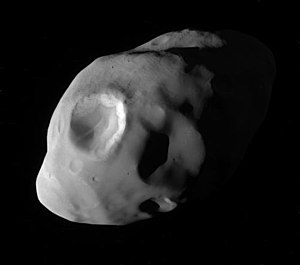Pandora (moon)

View of Pandora's western hemisphere.
|
|
| Discovery | |
|---|---|
| Discovered by | Collins, Voyager 1 |
| Discovery date | October, 1980 |
| Orbital characteristics | |
| Epoch December 31, 2003 (JD 2453005.5) | |
| 141720±10 km | |
| Eccentricity | 0.0042 |
| 0.628504213 d | |
| Inclination | 0.050°±0.004° to Saturn's equator |
| Satellite of | Saturn |
| Physical characteristics | |
| Dimensions | 104 × 81 × 64 km |
|
Mean radius
|
40.7±1.5 km |
| Volume | ≈ 280000 km3 |
| Mass | (1.371±0.019)×1017 kg |
|
Mean density
|
0.49±0.06 g/cm3 |
| 0.0026–0.0060 m/s2 | |
| ≈ 0.019 km/s | |
| synchronous | |
| zero | |
| Albedo | 0.6 |
| Temperature | ≈ 78 K |
Pandora (/pænˈdɔərə/ pan-DOHR-ə; Greek: Πανδώρα) is an inner satellite of Saturn. It was discovered in 1980 from photos taken by the Voyager 1 probe, and was provisionally designated S/1980 S 26. In late 1985 it was officially named after Pandora from Greek mythology. It is also designated as Saturn XVII.
Pandora was thought to be an outer shepherd satellite of the F Ring. However, recent studies indicate that it does not play such a role, and that only Prometheus, the inner shepherd, contributes to the confinement of the narrow ring. It is more heavily cratered than nearby Prometheus, and has at least two large craters 30 kilometres (19 mi) in diameter. The majority of craters on Pandora are shallow as a result of being filled with debris. Ridges and grooves are also present on moon's surface.
The orbit of Pandora appears to be chaotic, as a consequence of a series of four 118:121 mean-motion resonances with Prometheus. The most appreciable changes in their orbits occur approximately every 6.2 years, when the periapsis of Pandora lines up with the apoapsis of Prometheus and the moons approach to within about 1,400 kilometres (870 mi). Pandora also has a 3:2 mean-motion resonance with Mimas.
...
Wikipedia
